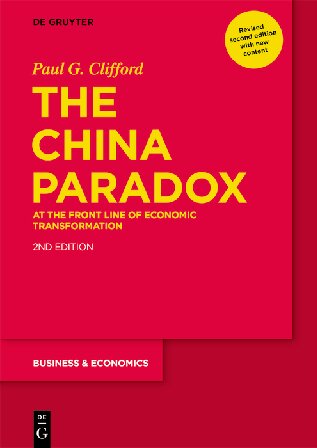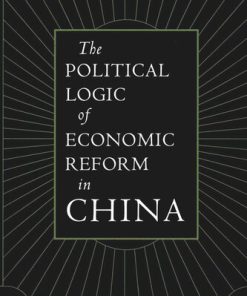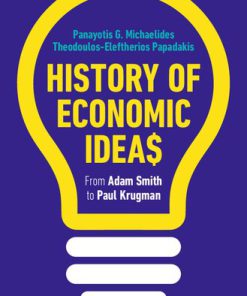The China Paradox At the Front Line of Economic Transformation 2nd edition by Paul Clifford ISBN 9783110724264 311072426X
$50.00 Original price was: $50.00.$25.00Current price is: $25.00.
The China Paradox At the Front Line of Economic Transformation 2nd edition by Paul G. Clifford- Ebook PDF Instant Download/Delivery: 9783110724264, 311072426X
Instant download Full Chapter of The China Paradox At the Front Line of Economic Transformation 2nd edition after payment

Product details:
ISBN 10: 311072426X
ISBN 13: 9783110724264
Author: Paul G. Clifford
Table of contents:
Chapter 1 The Hybrid Development Model at the Heart of a Vibrant New China
Chapter 2 Early Attempts at Industrialization: The Empire and the Republic
Chapter 3 The First Decades of the People’s Republic: The Soviet Model … and Worse
- The Fate of China’s Capitalists: From Ally to Enemy
- The Dysfunctional Soviet Model Is Embraced
- And Worse … Beyond the Soviet Model
- The Brutal Assault on Intellectuals and Science
- The Dead End of the Mao Years
Chapter 4 Wrongs are Righted, the Reforms Take Shape
- Interview with a “Counter-Revolutionary Element”
- Setting the Boundaries of Change
- The Initial Reforms – Limited and Tentative
- A Brave Factory Outguns the Central Government
- The Reforms Go into High Gear
- The Reforms Lose Steam (2002 Onward)
- China’s Economic Planning Today
Chapter 5 What to Do with the State-Owned Enterprises?
- Weaning the SOEs Off the State (1978–93)
- Central Planning Fades Away
- Addressing Ownership and Governance (1993–2003)
- Selling Off the “Dogs”
- Transforming the Large SOEs
- Management Consulting to the Rescue
- Diagnosing the Problems
- What Do We Want to Be?
- Good Company, Bad Company
- Who Actually Owns Us?
- Can SOE Culture Be Changed?
- SOE Reform Falters (2003 Onward)
- A New Type of SOE Shows the Way Forward
Chapter 6 The Private Economy Emerges Unannounced
- TVEs – Engine for Growth as the Reforms Took Shape
- POEs Flourish, Especially If Far from the Capital
- Wanxiang – A Pioneering Private Company Forges Its Own Path
- Alibaba – The Consequences of Not Showing Servility to the Party
- Just Twenty-Two Years of Stunning Growth
- How Things Have Unraveled
- A Fateful Conference
- Private Firms Sustain the Economy But Must Remain Acquiescent
Chapter 7 Huawei: A Private Company Becomes a National Champion
- History of China’s ICT Industry
- Huawei’s Origins
- 1998–1999: A Pivotal Year for Huawei
- Huawei 20 Years Later – Its Scale and Scope
- Punching Bag of the Trump Administration
- Where Does Huawei’s Funding Come From?
- Who Owns and Controls Huawei?
- How Does Huawei Compete and Does It Innovate?
Chapter 8 Magnet for Foreign Investment
- Why Did China Welcome FDI?
- Why Has China Been So Attractive to Foreign Investors?
- China Has Its Cake and Gets to Eat It, Too
- Win-Win in the Auto Industry
- The Starting Point
- Volkswagen: An Early Entrant Pays Its Dues
- The Foreign Component Suppliers Arrive
- General Motors Benefits from a Late Entry
- Local Auto Firms Fail to Impress
- The Greening of China’s Auto Industry
- Why Did China Neglect Logistics and Resist Its “Opening Up” to FDI?
- The Woeful State of China’s Logistics
- The Motorola Breakthrough
- The Curious Case of Casinos in China
- Satisfying Consumer Demand
- Why FDI Will Stick with China
Chapter 9 Business Models at the Heart of China’s Emergence
- Model 1. Learn and Catch Up
- Disappointment in Auto and Semiconductor
- The Model Works Well – In Consumer Products, High-Speed Rail, and Nuclear Power
- Model 2. Picking Off Underperforming Overseas Assets
- Obstacles to China ODI
- How Lenovo Mastered the Art of Turning Around a Troubled US Business
- Successful Overseas Auto Industry Acquisitions
- Model 3. “China, Inc.” in Emerging Markets
- The Government/CCP
- Financial Institutions
- Chinese Firms
- A Little-Known Firm from Anhui Grows and then Falters in Africa
- Transportation, Mines, and Downstream Industry
- Model 4. Novel Product or Technology Breakthrough
- Implications for the Emergence of Chinese Firms on the Global Stage
Chapter 10 China’s Friction with the World
- A Glance Back at the Emergence of Globalization
- How Does China Position Itself Today?
- A More Assertive China Draws Attention to its “Rise”
- Human Rights Abuses
- Is the BRI a Neo-Colonial Program?
- Does China Want to Export Its Development Model?
- Have We Been Fooled by China or Are We Kidding Ourselves?
- Racism Rears Its Head
- Trade War Breaks Out
- A Drift Toward Technology War?
Chapter 11 What Could Disrupt or Sustain the China Paradox?
- Peace, Stability and the CCP
- The CCP Has Survived and Adapted
- How Well Is the CCP Functioning Today?
- The CCP Is Embedded in Businesses
- China’s Fault Lines, Tensions, and Crimes Against Humanity
- The CCP and China’s Future
- Will Xi Serve Beyond His Second Term?
- Xi Jinping’s Cult of Personality: Ecology and Yucun Village in Zhejiang
- The Rule of Law or Rule by Law?
- Culture, Education, and Civil Society
- A Cocktail of Confucianism and Leninism
- Anything Goes, as the Market Latches onto New-Found Freedoms
- Corruption, Moral Turpitude, and Social Alienation
- Education Falls Short
- Business Education Flourishes
- Economic and Financial Stability
- Confronting the Environmental Crisis
- The Mega Domestic Market
- Gleaming New Ground Transportation Infrastructure
- Government-Sponsored Research and Development
- The Mobile Handset Example
- R&D Results Were Patchy but Outlook Is More Positive
- Connecting with the Consumer
- Prospects of Deepening Economic Reform
Chapter 12 Conclusions
People also search:
the china questions 2 critical insights into us-china relations
the china questions 2
the china pandemic book
china paradox
the china paradox
china in the 21st century pdf
You may also like…
Uncategorized
Politics & Philosophy - General & Miscellaneous Philosophy
Business & Economics - Management & Leadership
Digital Transformation at Scale Why the Strategy is Delivery Greenway
Science Fiction
Computers - UNIX & Linux
Efficient Linux at the Command Line: Boost Your Command-Line Skills 1st Edition Daniel J. Barrett











